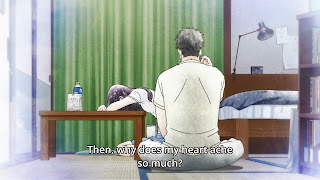Tokyo Ghoul Episode 12
This finale heavily used white and red for compositional
purposes. White is often associated with purity and good. Red is an intense and
eye grabbing color that’s attached to strong emotions, whether they’re positive
(love, passion, excitement) or negative (hate, pain, violence). The latter
being the representative meaning of red in this episode.
The centered wide shot of Kaneki and Rize gives a strong
visual of what each character represents. The white flowers are an imagery of
what Kaneki aspires to be, which is kind, pure and caring just like his mother.
Rize is the ghoul side of Kaneki that infringes upon this vision of himself and
tries to awake his real emotions. This is reinforced by the white flowers
turning red within her vicinity.
 |
 |
In Kaneki’s memory sequence about his mother the white and
red flower imagery continues to hold significance. In the first shot, the white
flowers are symbolic of a happy moment that exemplifies his mother’s kindness. In
the second one, the flowers turn red as Kaneki re-experiences the painful
memory of his mother dying. These shots also show that imagery can be the point
of interest despite being in the background and even out of focus as long as it’s
established convincingly.
The overhead shot of Kaneki and Rize in a sea of red flowers
is the culmination of long held emotions being released. First of these
emotions was the pain of not being chosen by his mother over his aunt and the
resentment that came along with it. More importantly the red signifies his choice
to be a ghoul and the acceptance of violence for the sake of people he cares
for.
__________________________________________________________________________
I really liked the way this scene uses circular camera movement.
It functions as a way to put more dramatic focus on Kaneki’s anguish and to
transition to the horrible vision causing that anguish. The circular movement
almost feels like a cycle of pain and misery.
________________________________________________________________________
 |
 |
The use of one point perspective in these shots works in multiples
levels. Both shots make Kaneki look distant from what he’s witnessing. It
communicates his feeling of helplessness, unable to do anything as he watches
his mother get taken advantage of. These shots also isolate him and create a
sense of loneliness that stems from his mother’s inability to choose him over
anything.



also !! i think the red flowers are red spider lilies which is commonly associated with loss, longing, and abandonment.. and the white ones are carnations that symbolize love ((which is also usually given as gifts on Mothers day!!))
ReplyDeleteso although initially kaneki loves and respects his 'hardworking' and 'kind hearted' mother,, after reliving his past he realizes that his mothers inability to choose him over her sister in a way abandons him. and so the change of flowers reflects his realization that by not being strong and choosing one side over another will only lead to more painnn
Good observation. It's always nice to read a different take on scenes/shots.
DeleteActually, red spider lilies are associated with reincarnation. In my mind it would have more significance in him changing into the rabid ghoul we know now. In a way it is justified in that he almost kills or eats his human half and renews himself as a ghoul.
ReplyDelete